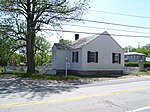Waterman Reservoir

Waterman Reservoir (also known as Waterman's Reservoir) is a large lake along Putnam Pike in Glocester and Greenville in Providence County, Rhode Island. The Waterman Reservoir was created in 1838 on the site of a swamp and is 318 acres (129 ha) when full with an average depth of nine feet (2.7 m). It was named after Resolved Waterman, an early eighteenth century Greenville resident and landowner. Prior to the creation of the reservoir, the area was swampy, so a dam was constructed to create the reservoir and at the same time a causeway (now part of the Putnam Pike) was built so travelers no longer had to go around the swamp using Austin Avenue, which prior to the 1930s was known as (Old) Killingly Road.
Excerpt from the Wikipedia article Waterman Reservoir (License: CC BY-SA 3.0, Authors, Images).Waterman Reservoir
Russell Road,
Geographical coordinates (GPS) Address Nearby Places Show on map
Geographical coordinates (GPS)
| Latitude | Longitude |
|---|---|
| N 41.87905 ° | E -71.58194 ° |
Address
Russell Road
02828
Rhode Island, United States
Open on Google Maps









